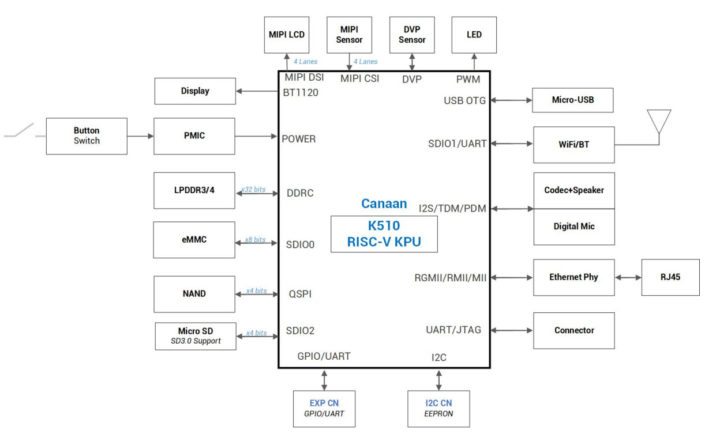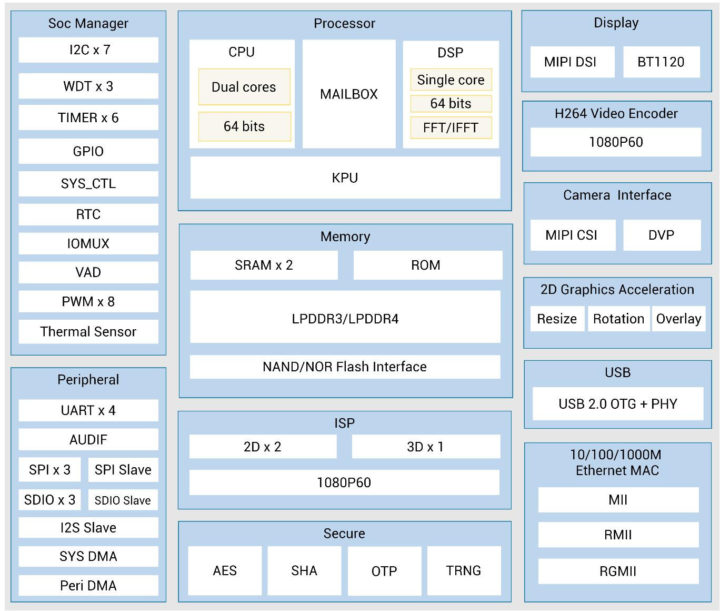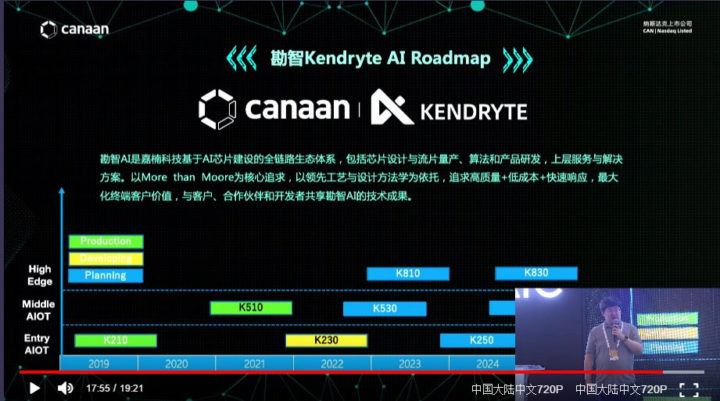Kendryte K510 is a 64-bit tri-core RISC-V processor clocked at up to 800 MHz with AI accelerators that succeed the 400 MHz Kendryte K210 dual-core RISC-V AI processor released a few years ago first in Kendryte KD233 board, and then boards like Maxduino or Grove AI HAT conveniently programmable with Arduino or Micropython.
Canaan formally announced the processor yesterday at the 2021 World Artificial Intelligence Conference claiming K510 had three times the performance of K210 making it suitable for UAV high-definition aerial photography, high-definition panoramic video conferences, robotics, STEAM education, driver assistance scenarios, and industrial and professional cameras.
The press release did not have much information, but multiple sources provided additional details to CNX Software, so we have Kendryte K510 specifications:
- Processor – 2x 64-bit RISC-V processor @ 800 MHz, and 1x 64-bit RISC-V core @ 800 MHz with DSP extension
- AI subsystem with 3 TOPS in total
- KPU: General Neural Network Engine (GNNE)
- Fast Fourier Transform (FFT): Decimation-in-time (DIT) Radix-2 FFT/IFFT
- Voice Activity Detection (VAD) supports 512kHz PDM, 16kHz PCM
- Memory
- Static RAM (SRAM) – 1 MB SRAM0 and 512 KB SRAM1
- Double Data Rate (DDR) – LPDDR3/LPDDR4
- Storage I/F – eMMC flash, SPI NAND flash,3x SD hosts and 1x SD slave block
- Video processing unit -H.264 encoder, JPEG encode
- Display I/F – MIPI DSI, MIPI DPHY TX, two-dimensional engine, and BT1120.
- Camera I/F – MIPI CSI, MIPI DPHY RX, ISP-2D, ISP-3D, and FBC
- Audio – PDM/TDM/I2S mode audio data as receiver and transmitter
- Networking – 10/100/1000Mbps Gigabit Ethernet MII/RMII/RGMII interfaces
- USB – USB On-the-Go (OTG) Dual-role device controller for a single peripheral device.
- Serial – 4x UARTs with RS485 interfaces
- Other peripherals
- 3x SPI master controllers and 1x SPI slave controller
- 32x GPIO
- 2x 4-bit PWM
- 4-channel SDMA (System DMA) for transactions between DDR and SRAM
- 16-channel PDMA (Peripheral DMA) for transactions between peripherals and DDR/SRAM
- Security
- One Time Program (OTP)
- Physical Un-clone Function (PUF)
- Advanced Encryption Standard (AES)
- Secure Hash Algorithm (SHA)
- Misc – Temperature sensor: 3 untrimmed accuracy (-40 to 100), 12-bit resolution, and power management; RTC, watchdog timer, 6x 32-bit timers
- Manufacturing process – 28nm

The processor can boot from SPI NAND flash, eMMC flash, the SD card, or even from UART. Kendryte K210 was interesting to play with but the performance is limited, and for instance, I got 15 to 18 fps in a face detection/tracking demo, and this type of lag is not suitable for robotics applications. Going from 1 TOPS to 3 TOPS in Kendryte K510 will certainly help with applications demanding faster response times. What I did not see are efficiency numbers in watts per TOPS. [Update: the company published some power consumption numbers: Typical power 2W; Standby Current < 2mA. ]
We’ve been told the SDK was still under development, and that stock would be limited to a few K samples this year due to the current lack of 28nm chip product capacity. So it’s more likely to become broadly available in 2022. That means manufacturers of low-cost AI camera boards will have to switch to other solutions such as Rockchip RV1109 processor this year.
Canaan also provides a longer term roadmap up to 2025 for Kendryte AI / AIoT RISC-V processors with two low-end processors coming in 2022 (K230) and 2024 (K250), two mid-range processors to succeed to K510 including K530, and high-end edge processor, I suppose for AI edge gateways, coming in 2023 and beyond with Kendryte K810 and K830.

Jean-Luc started CNX Software in 2010 as a part-time endeavor, before quitting his job as a software engineering manager, and starting to write daily news, and reviews full time later in 2011.
Support CNX Software! Donate via cryptocurrencies, become a Patron on Patreon, or purchase goods on Amazon or Aliexpress






